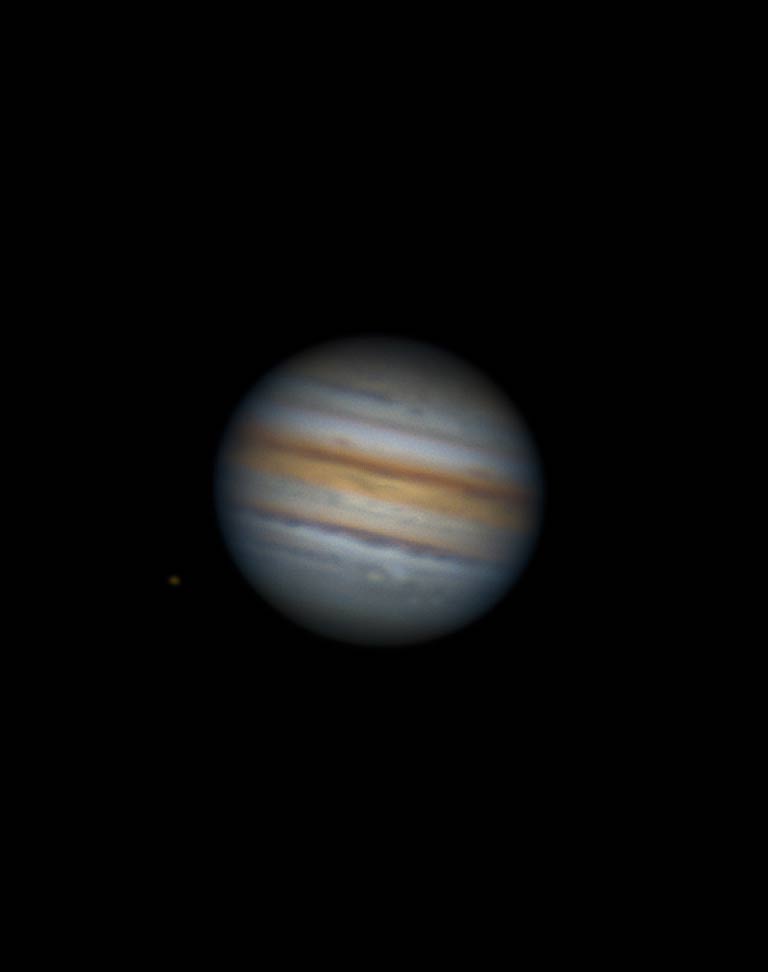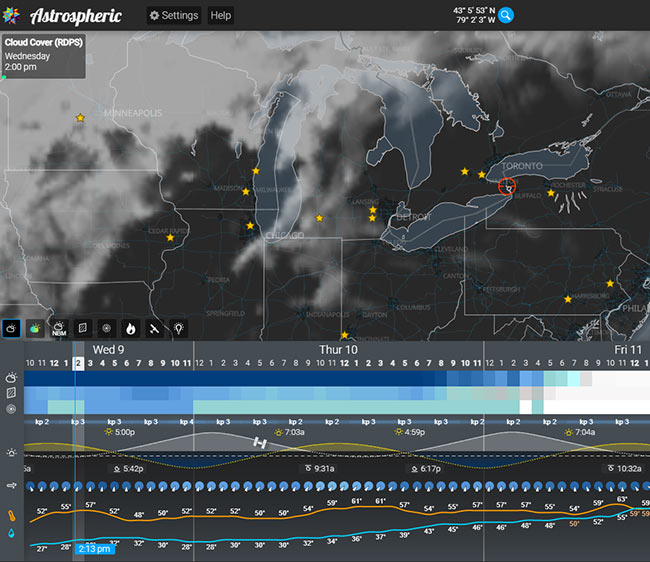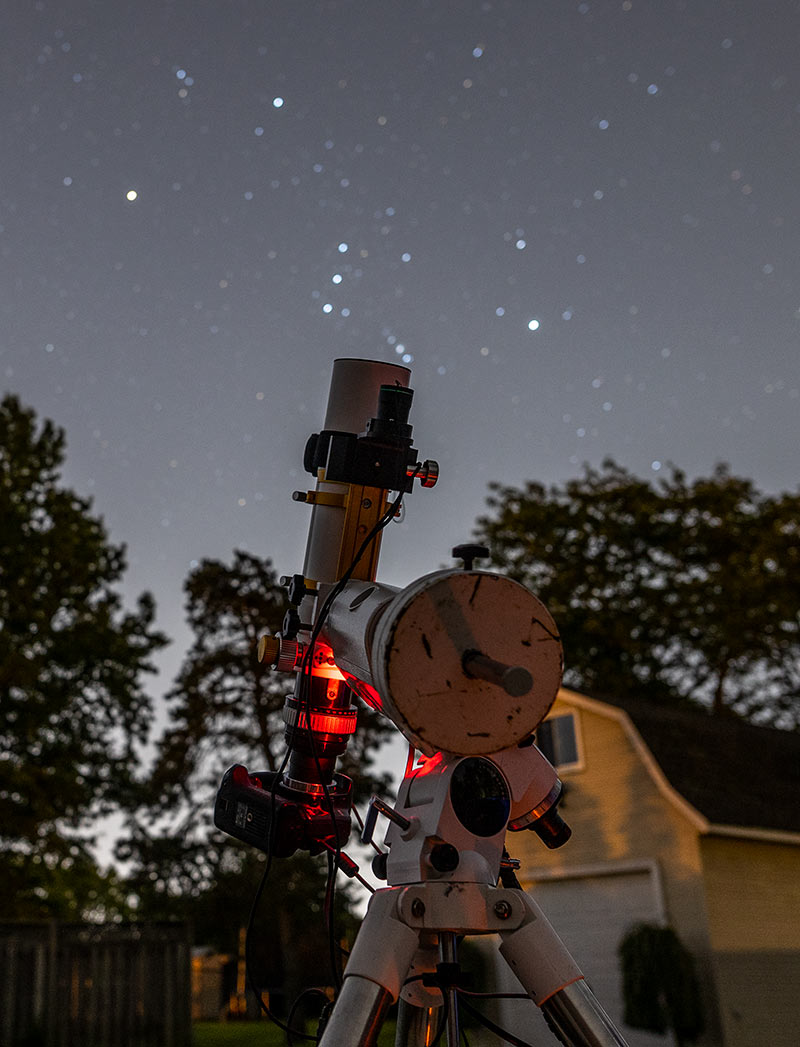What Are Seeing Conditions in Astronomy?
It will come as no surprise to you just how much the weather impacts astronomy. There are so many external factors at play and sometimes, a clear sky forecast is not enough. Much like cloud cover, seeing conditions can derail your imaging session, leading to less than ideal conditions.
As ground-based observers and imagers, we have to look through Earth’s thick atmosphere in order to see the stars in the sky. The term ‘seeing’ is used to describe the steadiness of that atmosphere, which varies by location in the night sky and over time.
As you may know, the purpose of the atmosphere is to protect us from the Sun’s harmful radiation. But it also means that there are several layers to see through when looking at the night sky. These layers, when shifted or disturbed, cause atmospheric turbulence and create bad/poor seeing conditions for astronomy and astrophotography.
Poor seeing conditions (also called astronomical seeing) lead to the degradation of the image of an astronomical object and can be an impactful limitation of your optical instrument.
I photographed the planet Jupiter during a night with poor seeing conditions.
Effects of Seeing Conditions
For visual observers, seeing conditions will dictate the amount of clarity on your subject when viewed through the eyepiece. For astrophotographers, seeing conditions will affect the level of detail and image sharpness your camera can collect through your telescope.
For objects like stars (point objects in the sky), atmospheric turbulence causes them to break up into speckles or coarse pixels appearing as fuzzy blobs and lacking sharpness. This turbulence also causes stars to twinkle during observation, which when mixed with high winds or large temperature differences, can impact the clarity of those stars in your image.
In the atmosphere, light travels through hot and cold air at different speeds. This moving and mixing air associated with high turbulence causes light to bend or refract before reaching your telescope. This causes objects to appear shaken or blurry.
Alternatively, during times of low atmospheric turbulence, you are able to see a greater amount of detail, specifically the moon or planets Saturn and Jupiter.
The Astrospheric stargazing app provides multiple forecasting models including seeing and transparency.
Good/Bad Seeing Conditions
Ideal seeing conditions are when there is the least amount of atmospheric disturbances. The result is sharp, steady views through your telescope. This can be during hot summer months when the air is heavy and humid or in locations where the topography is flat and there are fewer obstacles for air to interact with.
During times of bad seeing conditions, the high amount of turbulence will cause blurring, twinkling, or distortion of your objects through your telescope. Bad seeing produces turbulent, unstable telescope views of the Moon and shuddering, shaky images of stars. However, deep-sky objects like galaxies and nebulae aren’t as badly affected by poor seeing
The Sky-Watcher What’s Up webcast covered the topic of ‘seeing conditions’ in a lot of detail.
Measuring Seeing Conditions
While there are complex mathematical formulas used to measure seeing conditions, we won’t get into that here. However, there is a simple scale used by amateur astronomers to measure atmospheric conditions.
It’s called the Antoniadi Scale and it describes the best to the worst conditions, as shown below:
I. Perfect seeing, without quiver, no turbulence
II. Slight shimmers; moments of stillness that last several seconds
III. Moderate seeing; larger air tremors blur the image
IV. Poor seeing, constant troublesome undulations of the image
V. Very bad seeing; hardly stable enough for a quick sketch
Dealing with Poor Conditions
Even though we can’t control external factors like atmospheric turbulence, which causes poor seeing conditions, there are things we can do as imagers to fight against it at a local level.
Below are some tips that might help you deal with immediate and nearby disturbances:
- Take your telescope out a few hours prior to imaging: Minimizing the temperature difference between where your telescope is stored and the outdoor temperature will help the air inside the telescope to adjust and reduce tube currents, which can cause poor seeing.
- Set up on the grass: Finding a location on a natural surface will help reduce the disturbance of hot air that rises off nearby surfaces (like a hot driveway), which hold heat for long periods of time.
- Use a shorter focal length: Using a shorter focal length (wider field of view) telescope is more forgiving on the limitations of your seeing conditions as they are less pronounced.
- Image closer to the Zenith: Point your telescope away from the horizon, where there is more atmosphere and typically more turbulence and atmospheric dispersion.
- Image between midnight and dawn: This can be a good time to image as most of the surface heat has radiated back into the atmosphere. This will vary largely on your topography, as some say early evening is a great time to image – so get to know what works best for your location.
- Use a color filter: A filter can help when imaging certain targets, like the moon or planets, to help line up the colors of the object through the telescope.
- Use adaptive optics: Many large ground-based optical telescopes include adaptive optics to overcome seeing
An example of before/after using adaptive optics. Heidi B. Hammel and Imke de Pater (Sky and Telescope).
Seeing vs Transparency
Though they may sound similar, seeing conditions and transparency are not the same things – yet they can both impact the quality of your image or observing experience.
We now know that seeing conditions refers to the stability of the atmosphere and good seeing conditions involve a stable atmosphere.
Transparency, however, refers to the clarity or opacity of the night sky which is typically associated with cloud cover and/or humidity. You can think of it in terms of the transmission of visible light.
A good analogy, as seen on the Orion website, can be to think of a swimming pool. Your ability to see an object at the bottom of the pool is impacted by how steady the water is (i.e. seeing conditions) and how clear the water is (i.e. transparency).
Below is a chart that touches on some of the differences between the two factors:
| Seeing | Transparency |
|---|---|
| Stability of atmosphere | Clarity of the atmosphere |
| Typically better in flat typography (fewer obstacles for air) | Typically better with altitude (looking through less air) |
| Worse after a storm front (air is turbulent for a few days afterwards) | Better after a storm front (all particulates are cleared out of the air) |
| Moon and stars are good targets for good seeing conditions. | Faint objects like nebulae and galaxies which benefit from high contrast, are good targets for transparent conditions. |
Running my camera and telescope on a night with particularly great transparency.
Forecasting Seeing Conditions
It can help to keep an eye on the weather conditions to help determine what the seeing conditions will be like.
There are a lot of great apps for your phone that can help you determine the seeing conditions for your location, along with other important factors like cloud cover and transparency. It is a good idea to have a few different options to look at so you don’t rely on just one app.
Here are a few options:
- Clear Dark Sky: a web app meant for amateur astronomers in Canada, USA and parts of Mexico. It provide a 96 hour prediction for a specific site. The data comes a forecast model developed by Allan Rahill of the Canadian Meteorological Center and provides information on cloud cover, transparency, seeing, darkness, smoke, wind, humidity, and temperature.
- Clear Outside: a free app available for Android and iOS developed by First Light Optics. Though it focuses on cloud cover, it does provide rain and frost information and an estimated sky quality/Bortle class.
- Astrospheric: a free app available for Android and iOs developed by Daniel Fiordalis. It updates the data four times a day, providing a 48 hour forecast. It includes information on clouds, transparency, seeing, wind, temperature, dew point, long-range cloud forecast, and moon details.
There are many others that I haven’t used including Xasteria, Meteoblue, Netweather, Weatherweb.




